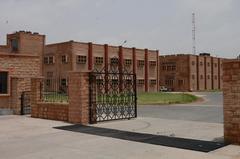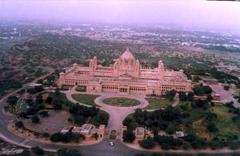
Comprehensive Guide to Visiting Jodhpur, Jodhpur District, India
Publication Date: 29/07/2024
Captivating Introduction
Welcome to Jodhpur, the ‘Blue City’ of Rajasthan, where every corner bursts with history, culture, and vibrant hues. Imagine strolling through streets bathed in shades of azure, a sea of blue houses enveloping you in a surreal, almost otherworldly ambiance. This captivating city, founded in 1459 by Rao Jodha, boasts a rich tapestry woven with tales of valor, architectural splendor, and cultural vibrancy. From the imposing Mehrangarh Fort that dominates the skyline to the serene Jaswant Thada, Jodhpur is a treasure trove of experiences waiting to be uncovered. Whether you’re a history buff, an architecture enthusiast, or a culture vulture, Jodhpur promises an unforgettable journey through the heart of Rajasthan (Indian Visit, Times of India, The Wander Therapy).
Table of Contents
- History of Jodhpur
- Major Attractions in Jodhpur
History of Jodhpur
Introduction
Welcome to Jodhpur, the ‘Blue City’ where every building tells a story and every street whispers secrets of the past. Imagine a city where the sky kisses the rooftops painted in vibrant hues of blue, creating a surreal landscape that’s as mesmerizing as it is mysterious. Intrigued? Let’s dive into the captivating history of Jodhpur!
Founding and Early History
Jodhpur, often referred to as the ‘Blue City’ due to its distinctive blue-painted houses, was founded in 1459 by Rao Jodha, a chief of the Rathore clan. The city was initially known as Marwar, which translates to ‘Land of Death,’ a name reflecting the harsh conditions of the Thar Desert. Rao Jodha established Jodhpur as the capital of the Marwar kingdom, strategically positioning it on the trade route between Delhi and Gujarat, which facilitated its growth and prosperity (Indian Visit).
The Rathore Dynasty
The Rathore dynasty played a significant role in shaping the history and culture of Jodhpur. Rao Jodha’s successors continued to expand the kingdom, and the city flourished under their rule. The Rathores were known for their valor and chivalry, often engaging in battles to defend their territory. The construction of the imposing Mehrangarh Fort, which began under Rao Jodha, was a testament to their architectural prowess and strategic acumen. This fort remains one of the most iconic landmarks of Jodhpur (Times of India).
Mughal Influence
In the 16th century, Jodhpur came under the influence of the Mughal Empire. The Rathore rulers formed alliances with the Mughals through matrimonial ties, which brought relative peace and stability to the region. This period saw a blend of Rajput and Mughal architectural styles, evident in the palaces and forts of Jodhpur. The Mughal influence also extended to the administrative and cultural aspects of the city, enriching its heritage (The Wander Therapy).
British Colonial Era
The British colonial era marked a significant transformation in Jodhpur’s history. During the 19th century, Maharaja Umed Singh played a pivotal role in modernizing the city. Under his rule, Jodhpur saw the construction of the Umaid Bhawan Palace, a magnificent structure that combined Eastern and Western architectural styles. This palace was built during a period of drought to provide employment to the local population, reflecting the Maharaja’s commitment to his people (Tusktravel).
Post-Independence Era
After India gained independence in 1947, Jodhpur became a part of the newly formed state of Rajasthan. The city continued to grow and develop, becoming the second-largest city in the state. The Marwari merchants of Jodhpur emerged as significant players in India’s trade scene, contributing to the city’s economic prosperity. Today, Jodhpur is a vibrant blend of its regal past and modern advancements, attracting tourists from around the world (Misfit Wanderers).
Architectural Marvels
Mehrangarh Fort
Mehrangarh Fort, perched on a rocky cliff 400 feet above the city, is a monumental structure that dominates Jodhpur’s skyline. Founded by Rao Jodha in 1459, the fort showcases exquisite Rajputana architecture with its thick walls, detailed carvings, and expansive courtyards. The fort also houses a museum that displays an impressive array of royal artifacts, including palanquins, costumes, and weaponry, providing insight into the rich history and culture of Rajasthan (Tusktravel).
Umaid Bhawan Palace
Constructed during the reign of Maharaja Umed Singh, Umaid Bhawan Palace is a blend of Eastern and Western architectural styles. This majestic palace, part residence, and part museum, houses the royal family of Jodhpur. The museum section showcases an array of personal belongings of the royals, including an exquisite collection of vintage clocks and exotic furniture, allowing visitors a peek into the opulent lifestyle of India’s royal heritage (Indian Visit).
Jaswant Thada
Jaswant Thada is a stunning marble mausoleum near Mehrangarh Fort, built in the 19th century as a tribute to Maharaja Jaswant Singh II. Known as the ‘Taj Mahal of Rajasthan’ due to its architectural beauty, Jaswant Thada is set amidst lush gardens and overlooks a tranquil lake. It offers a peaceful retreat away from the hustle and bustle of the city, making it a must-visit destination for nature and history lovers (Times of India).
Cultural Significance
Jodhpur’s rich cultural heritage is reflected in its vibrant festivals, traditional music, dance, and art forms. The Marwar Festival, celebrated in October, showcases traditional folk music, dance, and art forms, providing a glimpse into Jodhpur’s rich culture. Navratri, the nine-night festival dedicated to Goddess Durga, is celebrated with dance performances and religious rituals. The Nagaur Fair, held in February or March, is known for its livestock market, camel races, and folk performances (Indian Visit).
Visitor Tips
- Respect Local Customs: When visiting temples and sacred sites, it is essential to respect local customs and traditions.
- Weather Precautions: Jodhpur experiences extreme heat, especially during the summer months. Visitors should wear comfortable clothing, use sun protection, and stay hydrated.
- Local Cuisine: Indulge in the local cuisine, which includes dishes like Dal Baati Churma, Makhaniya Lassi, and Mirchi Bada.
- Shopping: The bustling bazaars of Jodhpur are perfect for shopping for handicrafts, textiles, spices, and traditional jewelry. The Clock Tower and Sardar Market are popular shopping destinations (Travel Melodies).
Conclusion
Jodhpur’s history is a tapestry of valor, architectural brilliance, and cultural richness. From its founding by Rao Jodha to its modern-day allure, the city offers a unique blend of tradition and modernity. Visitors to Jodhpur can immerse themselves in its regal past, explore its architectural marvels, and experience its vibrant culture, making it a must-visit destination in Rajasthan.
Interactive Elements
- Challenge: Find the hidden blue house with the most intricate carvings in the old city. Share your discovery with a photo on social media!
- Mini-Quest: Taste five different traditional Rajasthani dishes and rate them from least to most spicy. Dare your friends to take on the challenge!
Local Lingo Lessons
- ‘Khamma Ghani’: A warm greeting meaning ‘Hello’. Pronunciation: khum-ma gha-nee.
- ‘Padharo Mhare Desh’: Welcome to my land. Pronunciation: pa-dha-ro mha-re desh. Use this to charm the locals!
Myth Busting and Surprises
- Myth: Jodhpur is always scorching hot. Reality: While summers are hot, the winters are quite pleasant and perfect for exploring the city.
- Surprise: Did you know the blue color of the houses in Jodhpur is believed to repel heat and mosquitoes?
Storytelling Elements
Picture this: A young Maharaja, just 15 years old, leads his troops into battle, showcasing unparalleled bravery. This tale of valor is immortalized within the walls of Mehrangarh Fort, each brick echoing the courage of the Rathores.
FAQ
- Q: What’s the best time to visit Jodhpur?
- A: October to March, when the weather is pleasant for sightseeing.
- Q: Are there any unique souvenirs to buy?
- A: Yes, look for Bandhani textiles, Jodhpuri jootis (shoes), and traditional Rajasthani jewelry.
- Q: How can I get around the city?
- A: Auto-rickshaws, taxis, and rental bikes are popular options.
Call to Action
Ready to explore Jodhpur’s rich history and vibrant culture? Download Audiala now and embark on a journey through the Blue City. With detailed guides, insider tips, and interactive elements, Audiala is your perfect travel companion. Don’t miss out—download Audiala today and start your adventure!
Major Attractions in Jodhpur
Mehrangarh Fort
Perched majestically on a rocky hilltop, Mehrangarh Fort is not just one of the largest, but also one of the most magnificent forts in India. Built in 1459 by Rao Jodha, this architectural marvel stands as a testament to Jodhpur’s rich heritage. Imagine the panoramic views of the ‘Blue City’ below, where the azure hues of the buildings create a sea of blue. Inside, the fort’s museum houses a treasure trove of artifacts, from ancient weapons to vibrant paintings and royal costumes. Don’t miss the cultural performances that bring traditional Rajasthani music and dance to life (Ghum India Ghum).
Umaid Bhawan Palace
A blend of Indo-European architecture, Umaid Bhawan Palace is a marvel built between 1928 and 1943 to provide employment during a famine. Today, it stands as a symbol of opulence, with part of it serving as a luxury hotel, another part as a museum, and the remaining section as the residence of the royal family. The museum gives you a peek into the royal lifestyle with exhibits like vintage cars and antique clocks (Holidify).
Jaswant Thada
Near Mehrangarh Fort lies the serene Jaswant Thada, a white marble cenotaph built in memory of Maharaja Jaswant Singh II in 1899. Often referred to as the ‘Taj Mahal of Marwar,’ it features intricate carvings and is surrounded by lush gardens, offering a peaceful retreat with beautiful views of the fort and city (Travel Around the World Blog).
Toorji Ka Jhalra Stepwell
Dive into history with Toorji Ka Jhalra, an 18th-century stepwell showcasing traditional Rajasthani architecture. Once essential for water storage, today it’s a favorite spot for photography and a testament to ancient engineering (Ghum India Ghum).
Mandore Gardens
Just 9 kilometers from Jodhpur, Mandore Gardens is a historical treasure trove featuring ancient temples, memorials, and rock terraces. Once the capital of Marwar, the gardens house cenotaphs of Jodhpur’s former rulers and temples dedicated to various Hindu deities (Laure Wanders).
Rao Jodha Desert Rock Park
Adjacent to Mehrangarh Fort, Rao Jodha Desert Rock Park, created in 2006, spans 72 hectares. It aims to restore the natural ecology of a rocky wasteland and features a variety of native plants adapted to the Thar Desert’s arid conditions (Laure Wanders).
Sardar Market and Clock Tower
In the heart of the old city, Sardar Market is a bustling marketplace centered around the iconic Clock Tower. Explore narrow lanes filled with shops selling spices, textiles, handicrafts, and jewelry (Holidify).
Bishnoi Village
Experience rural Rajasthan in Bishnoi Village, known for its environmental conservation efforts and traditional customs. Guided tours offer insights into the Bishnoi way of life, including wildlife protection practices and traditional crafts (Trip Savvy).
Osian Temples
About 65 kilometers from Jodhpur, Osian is an ancient town known for its beautifully carved Hindu and Jain temples dating back to the 8th and 11th centuries. The Sun Temple and Sachiya Mata Temple are must-visits (Holidify).
Pachetia Hill
For panoramic views of Jodhpur, hike up Pachetia Hill. The relatively easy hike offers stunning sunset views over the Blue City and Mehrangarh Fort (Laure Wanders).
Camel Safari
No visit to Jodhpur is complete without a camel safari across the Thar Desert. Various packages offer unique ways to explore the desert landscape, visit remote villages, and experience traditional lifestyle (Holidify).
Sardar Government Museum
In the Umaid Public Gardens, the Sardar Government Museum features artifacts that provide insights into Jodhpur’s history and culture. Exhibits include weapons, textiles, miniature paintings, and sculptures (Ghum India Ghum).
Conclusion
Jodhpur, with its rich history, architectural wonders, and vibrant culture, offers a plethora of attractions for visitors. From the majestic Mehrangarh Fort and opulent Umaid Bhawan Palace to the serene Jaswant Thada and bustling Sardar Market, the city provides a unique blend of experiences. Whether you’re interested in history, architecture, culture, or adventure, Jodhpur promises an unforgettable journey through the heart of Rajasthan. Download Audiala for beautifully crafted audio guides that enhance your exploration with expert insights and hidden gems, making your visit to Jodhpur truly memorable.
Call to Action
Jodhpur is more than just a city; it’s a living, breathing canvas painted with the hues of history, culture, and architectural brilliance. From the majestic Mehrangarh Fort to the opulent Umaid Bhawan Palace, each landmark tells a story of a bygone era. The city’s vibrant festivals, bustling markets, and delicious cuisine offer a sensory feast that immerses you in its rich heritage. As you explore Jodhpur, you’ll find that its blue walls are more than just a visual delight—they’re a testament to the city’s enduring spirit and timeless charm. So, pack your bags and let Jodhpur enchant you with its magic. And don’t forget to download Audiala to make your journey even more enriching, with expertly crafted audio guides that reveal the city’s hidden gems and fascinating stories (Misfit Wanderers, Travel Melodies).
References
- Indian Visit
- Times of India
- The Wander Therapy
- Tusktravel
- Misfit Wanderers
- Travel Melodies
- Backpackers in the World
- [Holidify](https://www.holidify.com/places/jodhpur/sightseeing-and-things-to-do




